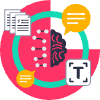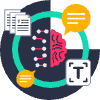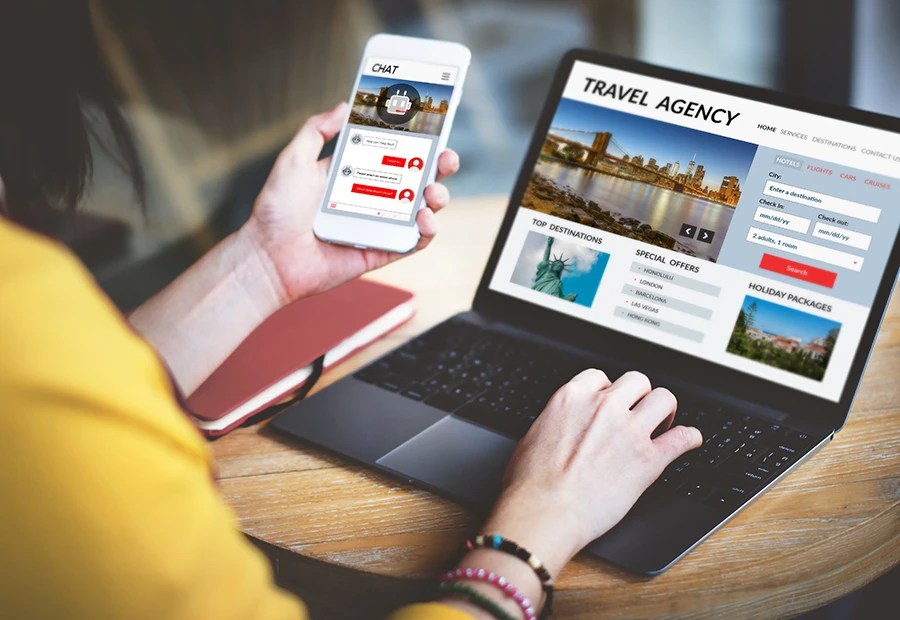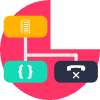To navigate through the page please click on the topic which interests you:
What is CCaaS?
Why was CCaaS developed and how has it evolved?
How does CCaaS differ from a traditional contact center?
What are the key features and benefits of CCaaS?
Which industries are CCaaS solutions designed for?
Are there real-life examples of CCaaS successes?
How to choose a CCaaS provider
Market trends and the future of CCaaS
Are there any challenges to overcome when deploying a CCaaS solution?

What is CCaaS?
CCaaS solutions are a customer interaction and contact center management platform. They are different from traditional contact center solutions because the software is maintained by the provider on their servers and contact centers access all the cutting-edge features through the cloud using a secure login protocol. This means agents can work from anywhere while also being supervised and frees contact centers from installation and maintenance of complex on-premises setups.
Why was CCaaS developed and how has it evolved?
CCaaS emerged as a response to the limitations of traditional on-site contact center solutions. The rapid evolution of technology commonly outstripped the adaptability of static on-site systems. These legacy solutions are often complex, costly, and necessitate manual updates, rendering them less efficient and more resource intensive. Operational constraints also arise when trying to scale in real-time to meet demand and from the rise of remote work. CCaaS’s cloud-based architecture addresses these issues by providing an agile, scalable, and accessible platform, aligning with dynamic modern business needs.
As the variety of cloud-based software and APIs has increased, CCaaS solutions have evolved to offer a more open architecture facilitating integration of other platforms and tech. One area generating a lot of interest is the integration of Generative AI.

How does CCaaS differ from a traditional contact center?
CCaaS solutions are not a replacement for contact centers, they are just a much-needed replacement for the traditional on-site technology contact centers used to rely on.
CCaaS solutions can be used in a physical contact center location or by agents working remotely. Their purpose is to enhance scalability, accessibility, and flexibility so contact centers, irrespective of the operational model (on-site or remote) can cater to the demands of modern customer service.
What are the key features and benefits of CCaaS?

CCaaS solutions provide a wide variety of customer contact channels
Traditional phone calls are still very important to customers, and modern CCaaS systems include advanced call management and distribution features like AI-infused IVR (Interactive Voice Response) for qualification and dynamic call routing. For personalization, 24/7 service and on-the-go convenience many other channels are also included:

offers an asynchronous channel which many customers still use to send inquiries, report issues, or seek assistance.

offers real-time online assistance from customer service agents.

is still widely used and trusted.

integration offers both support and cultivates brand communities on platforms like Facebook, Twitter, or Instagram.

like WhatsApp is widely used and trusted by customers.

can be especially useful for visual support or troubleshooting.
Voicebots, chatbots and AI can partially or fully automate interactions on all these channels, the exception being video.
CCaaS solutions offer a range of features
CCaaS solutions offer a comprehensive package of features which can be grouped and summarized by application:
These benefit contact centers in multiple ways including customer experience benefits and business benefits.
Business features and benefits
CCaaS solutions offer a variety of features and advantages for businesses:

provide scalability, flexibility, and cost-efficiency. Businesses can easily adjust to meet changing demands.

for example with a CRM create a unified view of customer interactions and empower data-driven decision-making, improving customer experiences and operational efficiency.
Contact center features and benefits
CCaaS (Contact Center as a Service) solutions offer a host of features and advantages tailored to contact center operations:

Workforce management
supports hybrid working schedules and includes forecasting capabilities to efficiently predict and plan staffing needs.

Supervision features
enhance quality management, coaching and agent support, for example, real-time alerts, data visualization, call whispering, call barging, and call recording.

Customization options
allow routing and reporting to adapt to the unique requirements of different contact centers.

Automation
optimizes agent workflows, streamlines back-office tasks, and generates reports to enhance visibility and decision-making.

AI features
support agents and customers with next-step suggestions, voicebots and chatbots for self-service touchpoints, and refine qualification and routing processes, resulting in an all-around higher-performance contact center.

Customer experience features and benefits

Do CCaaS solutions integrate with other platforms and software?
CCaaS solutions are evolving to offer more integrations, thanks to open architecture, as organizations look to eliminate informational siloes and improve agent experiences.
CCaaS solutions integrate seamlessly with a range of other tools and software, including CRM systems (like Salesforce), Unified Communications as a Service (UCaaS) platforms (such as RingCentral or Teams), AI-driven solutions (like Google Dialogflow), and more.
This allows businesses to harness a wider range of capabilities while also streamlining their operations and providing a more comprehensive customer experience.
Which industries are CCaaS solutions designed for?
CCaaS solutions have the features every contact center needs to function. The diversity of features and ability to customize them also make CCaaS solutions great at tackling the unique challenges and pain points in any industry or vertical market.
Healthcare
| Challenge | Solution | Outcome |
| Data security and compliance | ✔️ Security features ✔️ Quality assurance | Trust and security |
| Continuity of care | ✔️ Real-time data sync ✔️ Omnichannel history | Case progression not repetition |
| Cost-efficient 24/7 care | ✔️ Automated and AI-led touchpoints | Decreased cost-to-serve |
Public Sector
| Challenge | Solution | Outcome |
| Diverse customer base | ✔️ Priority services ✔️ Refined qualification | Personalized service |
| Efficient inquiry handling | ✔️ Advanced routing ✔️ Case collaboration tools like UCaaS integration | Increased FCR |
| Cost-efficiency | ✔️ Automated and AI-led touchpoints | Decreased cost-to-serve |
Financial Services
| Challenge | Solution | Outcome |
| Legacy system challenges | ✔️ Cloud-based solution ✔️ Software integrations | Real-time information |
| Branch closures | ✔️ Voice and video channels ✔️ Case collaboration tools like co-browsing and UCaaS integration | Personalization and increased FCR |
| Security | ✔️ Secure login, ✔️ Certifications and security features | Customer trust |
Utilities
| Challenge | Solution | Outcome |
| Legacy system challenges | ✔️ Cloud-based solution ✔️ Software integrations | Real-time information |
| Call spikes | ✔️ WFM and forecasting ✔️ Automated and AI-led touchpoints | Plan for and react to call spikes in real-time |
| Customer sentiment | ✔️ Omnichannel history ✔️ Sentiment analysis | Enhanced personalization mitigates negative sentiment |
Travel and Tourism
| Challenge | Solution | Outcome |
| Seasonal fluctuations | ✔️ Pay-per-use pricing ✔️ WFM and forecasting | Rationalized costs |
| Complex queries | ✔️ UCaaS integration for collaboration ✔️ Outbound messaging to share knowledge resources | Increased FCR |
| Customer updates | ✔️ Outbound campaigns ✔️ Digital channels like IM | Proactive care and customer satisfaction |
Retail
| Challenge | Solution | Outcome |
| Connected journeys | ✔️ Omnichannel interactions ✔️ Software integrations | Streamlined experiences |
| Delivering personalization | ✔️ AI-generated next-step suggestions ✔️ Sentiment analysis | Tailored offers and support |
| Proactive engagement | ✔️ Outbound campaigns ✔️ Channel choice | Enhanced engagement |
Telecom
| Challenge | Solution | Outcome |
| Connected journeys | ✔️ Omnichannel interactions ✔️ Software integrations | Up-to-date advice |
| Proactive engagement | ✔️ Outbound campaigns ✔️ Digital channels | Increased up-selling and loyalty |
| Maintaining loyalty | ✔️ AI-generated next-step suggestions ✔️ Sentiment analysis | Enhanced personalization |
Are there real-life examples of CCaaS successes?
There are many success stories accessible via the websites of CCaaS providers. Some of the most impactful are those that emerged during the COVID pandemic which highlight both the customer experience benefits and unexpected agent benefits.
Belgium Telecom company VOO
The Belgium Telecom company VOO switched from on-site to fully remote in one week. Everything was achieved under the pressure of the health crisis and the amazing results were testament to the teamwork and collaboration of RingRing and Odigo. Initially, absenteeism dropped by almost 50% as the 188 agents were able to work in safety, at home
Customer Serveys
Strong evidence supporting the use of CCaaS also comes from numerous customer surveys which highlight the importance of personalized service, connected experiences and how highly great service influences loyalty and repeat purchases.
Salesforce
In 2023 the 6th Edition of Salesforce’s State of the Connected Customer shows that 65% of customers expect companies to adapt to their changing needs/preferences and 88% of customers say good customer service makes them more likely to purchase again. Without the omnichannel strategies and integration capabilities of a CCaaS solution, living up to these expectations is difficult.
How to choose a CCaaS provider
When choosing a CCaaS provider it’s important to remember that while they all provide for the basic/core needs of any contact center, not all contact centers are the same! What are the specific needs of your contact center and customer base and the high priority or specialized needs to do with your working processes, industry regulation and security?
Key criteria for evaluating and choosing a CCaaS provider
1. Platform and connectivity

While public cloud offers a great many benefits, in some instances hybrid/private cloud options are required. Assess if the provider offers options and solutions which align with your security and data requirements.

Evaluate seamless integration with CRM, UCaaS, analytics tools, and essential software.

Examine the provider’s network infrastructure, PoP locations, and global connectivity.

Ensure flexibility to accommodate fluctuating call volumes and business growth.
2. Security and compliance

Verify robust security measures, encryption, and compliance with industry regulations.

Check for relevant certifications (ISO, PCI DSS) based on your industry.
3. Operational excellence

Understand the transparent pricing model, avoiding unexpected costs.

Assess the quality of support and adherence to Service Level Agreements.

Inquire about plans for business continuity and data redundancy.
4. Advanced features

Evaluate capabilities for insights into performance and customer interactions.

Confirm the channels your customers need are provided.

Ensure appropriate AI-driven automation features are included, like qualification, routing and agent-assist.
5. Global operations

Verify support for multiple languages, currencies, and time zones if operating internationally.

Ensure an intuitive platform for both agents and administrators.

Request references and review successful case studies.
Questions to ask a prospective CCaaS provider
After reviewing the features and specifications of a CCaaS solution follow-up questions are often needed for more in-depth planning like deployment, optimization and customization questions.

1. Customization and functionality

2. Operational processes

3. Agent productivity and collaboration

4. Scalability and resource management
What are the most important security, compliance and data privacy considerations when choosing a CCaaS provider?
There are many aspects of data privacy and compliance that are a contact center’s responsibility. CCaaS solutions have comprehensive security features but do not replace the need for robust data privacy policies to meet the requirements of, GDPR for example. There are also outbound calling regulations and industry-specific requirements to consider but here are some of the many security features that CCaaS solutions offer:
Market trends and the future of CCaaS
The CCaaS industry is highly competitive and there are several well-known analysts like ISG, Gartner and Frost & Sullivan who assess and compare the quality of major providers such as Odigo, Genesys, Talkdesk, 8×8, Five9, Puzzel, Nice and Amazon. These analysts also undertake research to project and predict future trends.
Which major analyst reports evaluate and compare CCaaS solutions?
There are several yearly analyst reports that look at CCaaS solutions, for example:
- Frost Radar™: European Contact Centre Market
- Gartner® Magic Quadrant™ for Contact Center as a Service
- ISG Provider Lens™ for Contact Centre as a Service
CCaaS providers qualify for these reports depending on eligibility factors, not necessarily quality factors.
Which CX and CCaaS trends will impact contact centers?
The most significant trends in the customer experience (CX) and CCaaS market are the ones which deliver real-world effects like decreasing effort and frustration for customers and turning contact centers into profit centers.

Seamless interactions
It’s been talked about for a long time but customer frustration suggests contact centers aren’t maximizing on the omnichannel potential of CCaaS solutions.

AI mystery shoppers
Forbes suggests companies will create synthetic customers using generative AI and real-time data to gain insights into real customers’ behavior and predict optimal outcomes.

Sustainable CX
For many customers’ ethical choices are important and businesses and their CCaaS providers will need to showcase sustainable values.

Security-centric CX
As regulations continue to tighten and cybercrime evolves customers need assurances and contact centers need advanced protection.

Appropriate automation
Numerous surveys highlight the frustration of customers with self-service. Advances in AI will not replace the need for the right self-service strategy.

CX-driven value
Companies will prioritize building CX strategies that increase metrics like average order value and customer lifetime value, rather than competing solely on price.
How will CCaaS solutions change as technology evolves?
CCaaS will continue to adapt to integrate more technologies, perhaps the most imminent changes are those which will normalize technology which is already in limited use in the customer service industry:

UCaaS, CRM and 3rd party AI integrations.

AI-driven chatbots and personalization.

Real-time emotional analysis for tailored interactions.

Virtual reality and augmented reality experiences
Are there any challenges to overcome when deploying a CCaaS solution?
Common challenges faced by businesses when adopting CCaaS
While a CCaaS solution is technically ready to use, deploying one without a well-thought-through plan for change management will not result in a great experience. Leading providers have systems in place so contact centers can start experiencing benefits from day one.
Common challenges faced by businesses when migrating to the cloud
When it comes to cloud migration there are both practical challenges during actual migration and the cloud migration myths which can stand in the way of organizations choosing to move to the cloud.
Plenty of prominent organizations, like Forbes, McKinsey and Gartner, have highlighted the problems with generalizing the pros and cons of cloud migration. That’s why knowing the right questions to ask a prospective vendor is important.
One key point is that deployment of a solution and migration to the cloud often occurs simultaneously. However, they present different challenges and providers should have clear strategies that address the pain points of both. For example:
1. Immersion:
2. Identification:
3. Test:
4. Deployment :
What’s the best way to guarantee a smooth CCaaS deployment?
Choosing an experienced CCaaS provider means a tried and tested deployment strategy. These providers, with more advanced solutions, also design and build a platform that’s a natural fit for your organization, prior to deployment.
Here are a few other ways to guarantee a smooth deployment, many of which are factored into the plans of experienced providers

Staged deployment
gradually rolls out a new CCaaS solution to different teams or departments. This allows for thorough testing, troubleshooting, and adjustments before full-scale deployment.

Preserve the customer-facing experience
so that throughout the deployment process, the disruptions to customer interactions are minimal and service quality is maintained.

Optimize features for your contact center
so they align with your specific needs and goals. Customize workflows, routing, and reporting to maximize efficiency.

Tailor features to customer needs
by designing journeys based on their preferences and requirements.

Integrate other software
such as CRM, analytics, and productivity tools to ensure a cohesive and efficient operation across your organization.

